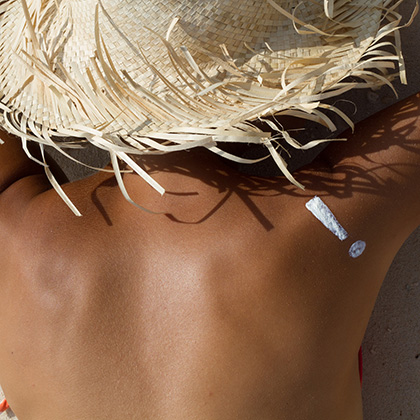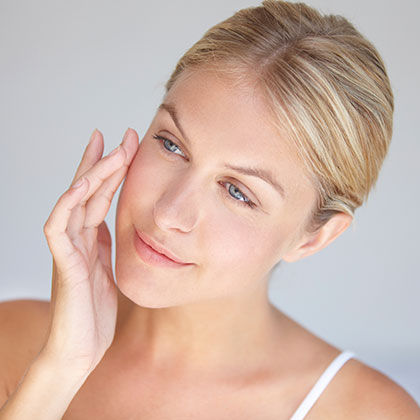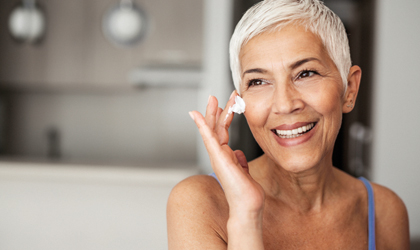The sun is essential for human health as unprotected sun exposure provides your body with its main source of vitamin D. It’s also been proven that sun exposure can help in the treatment of eczema (i). But if you spend too much time in the sun without protecting your skin, you run the risk of getting sunburned. And over time, sunburn can cause damage that can build up and lead to skin cancer.
Skin cancer is a common cancer in the UK and the number of people affected by it is increasing. According to the British Skin Foundation, at least 100,000 new cases of skin cancer are diagnosed here each year, with the disease killing more than 2,500 people annually(ii). Indeed, the average lifetime risk of developing malignant melanoma – an aggressive form of skin cancer – is estimated as one in 55 for men in the UK and one in 56 for women (iii).
Most experts agree that overexposure to the sun’s UV rays is the main cause of skin cancer. Indeed, according to Cancer Research UK, studies suggest that more than nine in 10 melanomas are linked to unsafe exposure to sunlight and the use of sunbeds (iv). Sunburn, says the charity, is a clear sign that the DNA in your skin cells has been damaged by too much UV radiation from the sun or sunbeds.
In fact, getting painful sunburn just once every two years can triple your risk of melanoma skin cancer (iv). And that doesn’t mean just the red raw type of sunburn either. Even if your skin has just turned pink, it’s still a sign of sun damage.
Getting a tan
When your skin is exposed to sunlight, cells called melanocytes produce more of a pigment called melanin to absorb UV radiation. It’s this pigment that gives you a tan by turning your skin darker.
It’s true that people who naturally have darker skin – those of African or Asian descent, for example – are less likely to burn than others with lighter skin. But that doesn’t mean getting a pre-holiday sunbed tan will protect you from sunburn. According to Cancer Research UK, some studies suggest that having a tan only offers protection equivalent to using a sunscreen with a sun protection factor (SPF) of three (v).
Which SPF?
Keeping your skin safe means using the right level of sun protection, whether you’re lying on a beach or simply out and about when it’s sunny.
The NHS recommends a sunscreen with a SPF of at least 30, whatever type of skin you have (vi). It also advises that you should go for broad-spectrum sunscreens that protect against harmful UVA and UVB rays (SPF is a measurement of the amount of UVB protection, while UVA protection is measured with a star rating – so choose at least four stars, with five being the highest number possible).
To make it easier for you to choose a sun protection product, some manufacturers have made changes to the labelling of their sunscreen. This means as well as displaying the SPF in a sun cream or lotion, the label will also show the level of protection as low to very high:
-
Low protection = SPF 6, 10
-
Medium protection = SPF 15, 20, 25
-
High protection = SPF 30, 50
-
Very high protection = SPF 50+
Choosing a product with at least SPF30 is a good place to start, but you may need a higher level of protection if you have fair or sensitive skin, if you have lots of moles or freckles, if you have a history of sunburn and/or a personal or family history of skin cancer, if you’re going to a very hot country or if you’re buying sun protection for children.
Also make sure you’re not using a sunscreen that’s out of date. Most products have a shelf life of two to three years (check the bottle for a small logo that looks like an opened jar and a number; the number represents the number of months you can use it for after breaking the seal.)
Sun safety dos and don’ts
Whether you go abroad or stay in the UK during the summer (and also the winter if you go somewhere hot for a sun break), here’s what you should do to look after your skin and help keep it as healthy as possible:
-
DO know which sun protection factor (SPF) is best for your skin type – for many people, that should be a minimum of SPF30.
-
DON'T forget to protect your eyes. If it's a sunny day, wear sunglasses. If possible, choose a wraparound style, as this protects the sides of your eyes too. If you’re buying a new pair of sunglasses, look for one of the following:
-
CE or British Standard mark (BS EN ISO 12312-1:2013)
-
UV 400 label
-
Label stating ‘100 percent UV protection’
-
-
DO apply sunscreen 30 minutes before going out into the sun to allow the ingredients to settle into the skin, and then again shortly after heading outdoors to cover any missed patches and to make sure you’re wearing a sufficient layer.
-
DON'T use any less than six full teaspoons of sunscreen to cover all the exposed parts of your body each time you apply it. Experts believe most people apply less than half the amount of suncream required to provide the level of protection stated on the label, so if in doubt, apply more rather than less. Use more than half a teaspoon of sunscreen to each arm and the face/neck (including ears), and just over one teaspoon to each leg, front of body and back of body.
-
DO keep reapplying sunscreen every two hours if you're constantly in the sun – if you're on the beach, for instance.
-
DON'T forget to apply more sunscreen after swimming, towel drying, perspiring or exercising.
-
DO use a higher SPF on your face, especially if you want to avoid wrinkles (and use a lip balm with sun protection too).
-
DON'T be fooled into thinking that light summer clothes will protect you from the sun – only clothes that are made of tightly woven fabrics shield your skin against UV rays, so always use sunscreen under your clothes if you're going out into strong sunlight.
-
DO wear a hat to protect your head and your face (and if it has a wide brim it could also protect your neck and shoulders).
-
DON’T spend time in the sun when it’s at its strongest – that is, between 11am and 3pm. Instead, spend as much time in the shade as possible, especially around midday.
-
DO cover up whenever possible by wearing a close-weave cotton t-shirt.
-
DON’T forget to keep drinking plenty of water, as it can help to stop your skin from becoming dehydrated. Apply plenty of moisturising creams or lotions to keep your skin from drying out too, slathering it on whenever you come out of the sun, ideally after having a bath or shower.
-
DO develop a habit of using sunscreen throughout the summer, not only when it’s hot and sunny (that includes when you’re at home as well as abroad). On overcast days, experts believe up to 80 percent of the damaging UV rays still get through the clouds, which means you could still burn even when the sun’s not out (vii).
There are always many health-related issues you should think about when you go abroad. Read more about common travel ailments here.
Sun safety for children
According to Cancer Research UK, studies suggest sunburn during childhood can increase the risk of skin cancer later on in life (viii). So if you want to reduce your child’s risk of developing skin cancer when they’re older, it’s essential to protect them from the sun from day one. Here’s what you should know:
-
Keep babies out of the sun at all times, at least until they’re three. If that’s not always practical, use an ultra-high-factor sunscreen on any parts of their skin that are exposed.
-
Apply sun cream about half an hour before letting children go out in the sun - this helps the ingredients settle into the skin.
-
Use a cream with the highest sun protection factor you can find (never less than SPF30), and make sure you apply plenty – don't skimp; use at least half a handful to cover a child's body. Choose a sun cream formulated especially for children that also has the highest UVA star rating (five stars).
-
Cover children up with loose, cotton clothing as an added protection. Special clothes with UV filters are available, but ordinary clothing made from tightly woven fabric will protect them too.
-
Whenever possible, keep children out of the sun between 11am and 3pm, which is when the sun is at its strongest.
-
Hats are also important, especially when it comes to children. Choose a hat with a brim, as baseball caps don’t provide enough protection.
-
Reapply sunscreen every two hours and get children into the habit of applying sunscreen themselves too. Don't forget to use sun protection when you're in the car, as UVA rays can penetrate glass.
-
Also reapply sunscreen when children come out of the pool or the sea. Even waterproof sun creams can get rubbed off while you’re drying your child with a towel, so play it safe and put more sun cream on after they’ve been swimming.
-
Make sure children drink plenty of water when they're in the sun – especially if they’re running about a lot – as dehydrated skin may be more susceptible to sun damage.
-
Don't forget to protect children's eyes, as damage caused by repeated UV exposure can increase the risk of chronic eye disease later in life. Look for sunglasses with a CE mark, as these provide 100 per cent UV protection.
Coping with the sun’s after effects
In an ideal world everyone would know about and follow sun safety advice and never have to get sunburned. But even the best-intentioned among us can get caught out if we’re unlucky. You know you have sunburn when it looks pink or red and feels hot and tender to the touch. It may even become swollen with blisters forming. Then after a few days it may start to peel.
Sunburn can be painful, but you can relieve the pain by taking an anti-inflammatory painkiller, which can help reduce redness and soreness. Applying a cold compress to the area of skin affected – or taking a cool bath or shower – may also help to reduce the temperature in your skin.
It’s also a good idea to use a soothing after-sun lotion or a cream, lotion or gel containing aloe vera, as it will help to keep your skin hydrated. This can prevent your skin from drying out too much, and may even help to reduce peeling.
While you have sunburn, make sure you drink lots of water to counteract the fluid being lost through your skin. And if any blisters form, don't burst them (if they burst on their own, treat them by applying an antibacterial cream).
Meanwhile, if your sunburn covers a large part of your body, is accompanied by a high temperature, pain or nausea, or doesn't improve within a few days, see your GP immediately.
Prickling sensation
Another after-effect of being exposed to too much sun – or, more specifically, too much heat – is a condition known as prickly heat. Creating a stinging or prickling sensation on the skin, this happens when your sweat glands become blocked, causing a rash with little spots that can look like blisters.
If you develop prickly heat, it’s important to keep your skin as cool as possible, which includes staying out of the sun. You can also soothe and cool your skin by applying calamine lotion or aloe vera lotion.
Mole check
Whenever you’ve been on holiday or spent time in the sun, it’s a good idea to check your skin for the early signs of skin cancer.
Look out for any changes such as marks or blemishes that are growing, bleeding, not healing or changing in appearance in any way. Also check your skin for moles, keeping an eye out for the following warning signs:
-
Asymmetry
The two halves of the mole may differ in their shape and not match. -
Border
The outside edges of the mole or area may be blurred, and sometimes show notches or look 'ragged'. -
Colour
This may be uneven or patchy. You may see different shades of black, brown and pink. -
Diameter
Most, but not all, melanomas are at least 6mm in diameter. If any mole gets bigger or changes tell your doctor.
If you notice these or any other changes to a mole or a patch of skin, see your GP as soon as possible.
Natural suncare remedies
Protecting your skin from the sun by using an effective sunscreen product is essential if you want to ward off signs of premature skin ageing and protect against skin cancer. But there are also certain nutritional supplements that may help to support your skin, which could be especially helpful if you’ve been spending lots of time in the sun. These include the following:
Anthocyanidins
These are powerful antioxidants called flavonoids that are found in the skin of dark and richly coloured fruit including blueberries, blackberries, raspberries and red grapes (the flavonoids are the pigments that give these fruits their distinctive colour). Anthocyanidins are thought to help strengthen collagen, a substance that provides skin with its structure – and which may be damaged by UV light (ix).
Lutein
Another antioxidant, lutein is a carotenoid found in green vegetables such as spinach, kale, lettuce, peas and leaks, and is arguably best known for its potential benefits in eye health. However, some researchers also believe it may protect the skin against some of the damaging effects of the sun, specifically UVB light (x).
Green tea
An antioxidant found in green tea called epigallocatechin gallate (EGCC) has been the subject of several studies that suggest it may have properties that could protect against skin inflammation and that it has properties that may protect against skin cancer caused by exposure to UBV light (xi). A review of studies into green tea’s potential skin anti-ageing effects also suggests it may help protect against sun damage (xii).
Fish oils
The omega-3 fatty acids found in oily fish not only help to reduce inflammation – which can be a result of sunburn – but studies also suggest they may protect against sunburn and DNA damage caused by excessive sun exposure (xiii).
Fish oil supplements containing beneficial omega-3 fatty acids are widely available, but you can now also get omega-3 supplements that are suitable for vegetarians and vegans. These contain the natural triglyceride (TG) form of omega-3, which is sourced from plant organisms called microalgae rather than fish.
Staying sun safe can really reduce the risk of contracting skin cancer, and the advice above should go some way in helping you do this. You can find more advice on a number of other common health conditions in our health library.
References:
-
Yu C et al., Nitric oxide induces human CLA+CD25_Foxp3+ regulatory T cells with skin-homing potential. J Allergy Clin Immunol. 2017 Nov;140(5):1441-1444.e6.Available online: https://www.jacionline.org/article/S0091-6749(17)30924-7/abstract
-
Available online: https://www.britishskinfoundation.org.uk/are-you-at-risk-of-skin-cancer
-
Available online: https://patient.info/doctor/malignant-melanoma-of-skin
-
Available online: https://www.cancerresearchuk.org/about-cancer/causes-of-cancer/sun-uv-and-cancer/how-does-the-sun-and-uv-cause-cancer
-
Available online: https://scienceblog.cancerresearchuk.org/2017/05/08/sun-awareness-week-10-new-sun-safety-myths-debunked/
-
Available online: https://www.nhs.uk/live-well/healthy-body/sunscreen-and-sun-safety/
-
Available online: https://www.aad.org/sun-protection/sunscreen-faqs
-
Available online: https://www.cancerresearchuk.org/about-cancer/skin-cancer/risks-causes
-
Jariashvili. K, Madhan. B, et al. UV damage of collagen: insights from model collagen peptides. Biopolymers. 2012 Mar;97(3):189-98.
-
Astner. S, Wu. A, et al. Dietary lutein/zeaxanthin partially reduces photoaging and photocarcinogenesis in chronically UVB-irradiated Skh-1 hairless mice. Skin Pharmacol Physiol. 2007;20(6)283-91.
-
Katiyar. SKM, Matsui. MS, Elmets. CA, et al. Polyphenolic antioxidant (-)-epigallocatechin-3-gallate from green tea reduces UVB-induced inflammatory responses and infiltration of leukocytes in human skin. Photochem Photobiol. 1999;69:148-153.
-
Elmets. CA, Singh. D, Tubesing. K, et al. Cutaneous photoprotection from ultraviolet injury by green tea polyphenols. J Am Acad Dermatol. 2001;44:425-432.
-
Elmets CA et al., Cutaneous photoprotection from ultraviolet injury by green tea polyphenols. J Am Acad Dermatol. 2001 ;44:425-432.
-
Rob E et al., Molecular mechanisms of green tea polyphenols with protective effects against skin photoaging. Crit Rev Food Sci Nutr. 2017 May 2457(8):1631-1637.Available online: https://www.ncbi.nlm.nih.gov/pubmed/26114360
-
Rhodes. LE, Shahbakhti. H, et al. Effect of eicosapentaenoic acid,, an omega-3 polyunsaturated fatty acid, on UVR-related cancer risk in humans. An assessment of early genotoxic markers. Carcinogenesis Volume 24, Issue 5, pp919-925.
Related Posts
Disclaimer: The information presented by Nature's Best is for informational purposes only. It is based on scientific studies (human, animal, or in vitro), clinical experience, or traditional usage as cited in each article. The results reported may not necessarily occur in all individuals. Self-treatment is not recommended for life-threatening conditions that require medical treatment under a doctor's care. For many of the conditions discussed, treatment with prescription or over the counter medication is also available. Consult your doctor, practitioner, and/or pharmacist for any health problem and before using any supplements or before making any changes in prescribed medications.

Christine
Christine Morgan has been a freelance health and wellbeing journalist for almost 20 years, having written for numerous publications including the Daily Mirror, S Magazine, Top Sante, Healthy, Woman & Home, Zest, Allergy, Healthy Times and Pregnancy & Birth; she has also edited several titles such as Women’ Health, Shine’s Real Health & Beauty and All About Health.
View More



